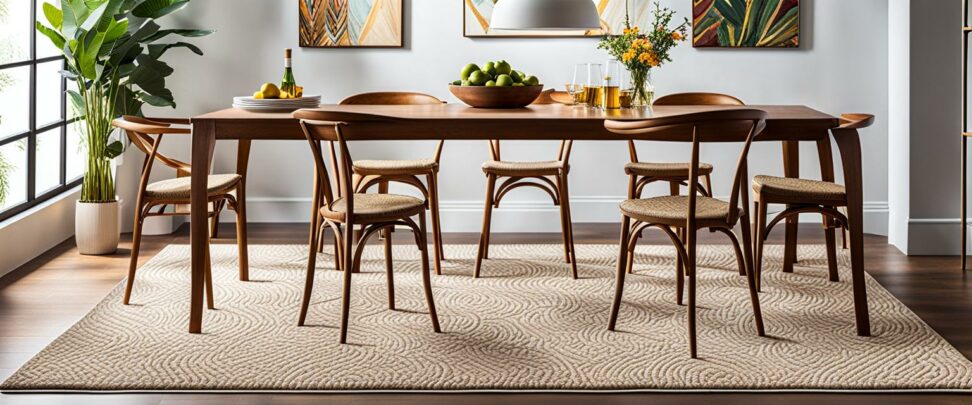Kitchen Rugs Under Tables - Complete Guide For [Year]
Whether you have a small bistro table or a large farmhouse dining table, placing a rug underneath can provide a range of benefits. From protecting your floors to adding a pop of color to your kitchen decor, rugs under kitchen and dining tables are a functional and stylish addition. This comprehensive guide will explore the advantages of using kitchen rugs, how to choose the right size and style, popular materials to consider, care tips, and more.
Kitchen rugs come in all different shapes, sizes, colors, and materials to not only look great but also serve practical purposes. Read on to learn everything you need to know to find your perfect kitchen rug!

Why Use Kitchen Rugs Under Tables?
Placing a rug under your kitchen or dining table offers several advantages that make them a worthwhile investment.
Protect Floors from Chairs
The constant dragging and scooting of chairs under your table can lead to scratches, dents, and other damage on your flooring over time. A kitchen rug provides a protective barrier between chairs and floors. The padding of a rug also absorbs noise and reduces scraping sounds from moving chairs.
Make Cleaning Easier
Kitchen rugs, especially ones made of absorbent materials like cotton, soak up spills quickly before they can spread across your floors. Look for rugs with materials specifically designed to be stain resistant for even easier cleanup. Machine washable rug options contain messes and can simply be tossed in the wash.
Add Style
While serving practical purposes, kitchen rugs can also elevate your space aesthetically. Choose a rug in a color or pattern that complements your existing kitchen decor. Solid colors visually expand smaller kitchens. Bold graphic prints inject visual interest into a neutral color scheme. Whatever your style, there’s a kitchen rug to match.
Improve Safety
Kitchen rugs with non-slip rubber backing help prevent dangerous slips and falls on hard kitchen floors. The soft, padded surface also cushions any falls or tripping. Improving traction and stability in a kitchen environment is a key safety benefit.
Choosing the Right Size Kitchen Rug
Properly measuring the under-table space is crucial for finding a rug that fits correctly without issues like tripping hazards from edges peeking out.
Measure Your Table
Start by measuring the length and width of the floor area that will sit directly underneath your table. Make sure to account for any leaf extensions if your table expands.
Consider Chair Movement
Add 12-18 inches of clearance on all sides of the table measurements you took. This allows enough room for chairs to easily slide in and out without catching or tugging the rug edges.
Common Sizes
Rectangular rugs tend to best fit the shape of space under most four-legged kitchen and dining tables. Some popular sizes include:
- 3x5 ft
- 4x6 ft
- 5x7 ft
- 6x9 ft
- 8x10 ft
Popular Kitchen Rug Materials
Kitchen rugs come in a variety of materials, each with their own advantages and disadvantages depending on your needs.
Cotton
Cotton rugs offer a soft and more absorbent surface than synthetic materials. The downside is frequent washings can cause cotton rugs to wear out and fray faster. But their affordability makes them easy to replace when needed.
Polyester
For those wanting colorfast and stain-resistant qualities without the higher price tag of wool, polyester is a good alternative. Polyester holds up well to heavy use but can develop pilling over time.
Wool
Woven wool rugs are naturally stain resistant while providing a luxurious look and feel. However, the higher cost means replacing a wool rug is a bigger investment if it becomes damaged. Shedding is also a common downside.
Synthetics (Polypropylene/Nylon)
Rugs made from synthetic polypropylene or nylon fibers are extremely durable choices that resist stains excellently. Their non-organic nature also makes them easy to clean. The tradeoff is synthetics don’t offer the same cozy factor underfoot as natural fibers.
Selecting Style, Color & Patterns
Kitchen rugs are available in a spectrum of colors, prints, textures, and shapes. Consider what best suits your space.
Solid Colors
Choosing a rug in a solid color allows you to seamlessly coordinate with existing kitchen decor. Solid hues also visually expand smaller kitchens better than busy patterns.
Bold Prints & Patterns
For those wanting to make a statement, lively graphic prints and geometric patterns add visual interest to kitchen floors. Busy patterns can also help hide everyday stains.
Shape Considerations
Rectangular rugs efficiently maximize under-table coverage. Round rugs can also work well for compact bistro tables. Runners protect high traffic areas like entries.
Texture Options
Low pile rugs are easiest to clean around foods and spills. Plush and shaggy options provide indulgent softness underfoot. Unique textures like braided and woven add visual appeal.
Caring for Your Kitchen Rug
Following proper care methods keeps kitchen rugs looking fresh for longer.
Regular Vacuuming
Frequently vacuuming the surface picks up debris, crumbs, and other spills that can grind into fibers if left over time.
Quick Sponge Cleaning
Promptly spot treat fresh spills by gently sponging with a damp cloth and mild detergent. Avoid excessive rubbing.
Wash Removable Rugs
For rugs labeled machine washable, periodically wash on delicate cycle and air dry flat to prevent curling edges. Check care tag each time.
Professional Cleaning
Hiring professional rug cleaning services every year or two provides a deep clean to help investments like wool last longer.
To get the most use out of any rug, rotate it periodically to evenly distribute wear. When it eventually shows signs of aging, replacing it keeps your kitchen looking fresh.
The right kitchen rug can be both decoratively pleasing and functionally useful for homes with dining tables. With measurements accurate to your specific table size, durable and easy-to-clean materials, and colors suited to your style, kitchen rugs protect floors, absorb messes, and complement your space.